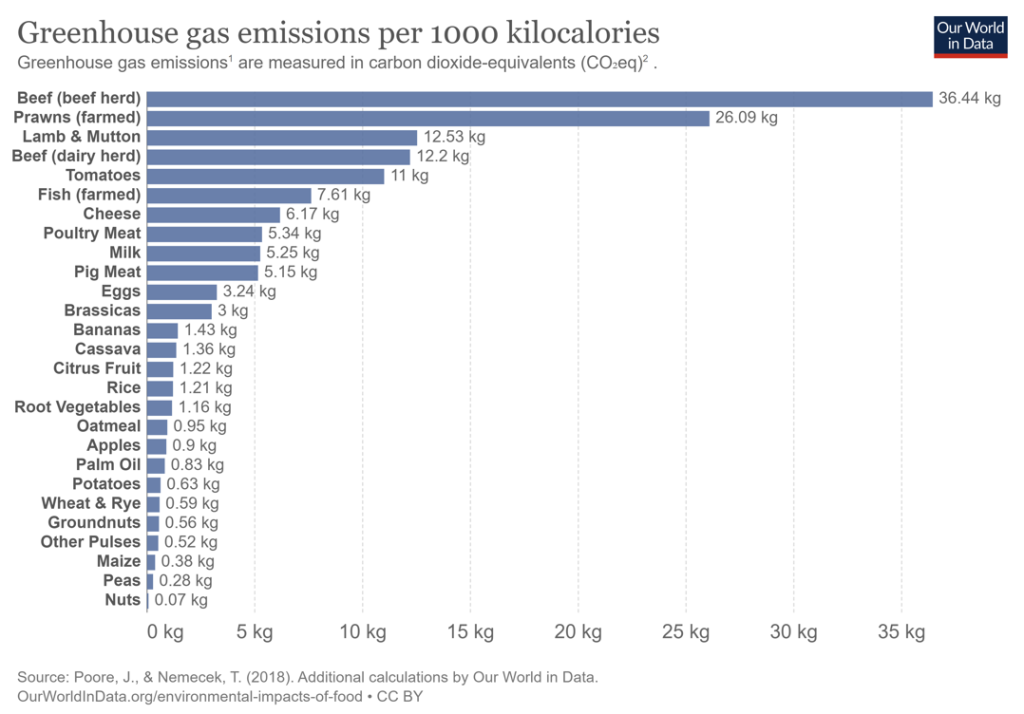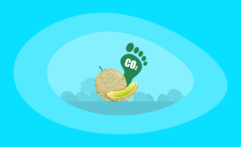What Is the Carbon Footprint of Bell Peppers? A Life-Cycle Analysis
Impactful Ninja is reader-supported. When you buy through links on our site, we may earn an affiliate commission.
Learn more
Learn more
.
Hey fellow impactful ninja ? You may have noticed that Impactful Ninja is all about providing helpful information to make a positive impact on the world and society. And that we love to link back to where we found all the information for each of our posts. Most of these links are informational-based for you to check out their primary sources with one click. But some of these links are so-called "affiliate links" to products that we recommend. First and foremost, because we believe that they add value to you. For example, when we wrote a post about the environmental impact of long showers, we came across an EPA recommendation to use WaterSense showerheads. So we linked to where you can find them. Or, for many of our posts, we also link to our favorite books on that topic so that you can get a much more holistic overview than one single blog post could provide. And when there is an affiliate program for these products, we sign up for it. For example, as Amazon Associates, we earn from qualifying purchases. First, and most importantly, we still only recommend products that we believe add value for you. When you buy something through one of our affiliate links, we may earn a small commission - but at no additional costs to you. And when you buy something through a link that is not an affiliate link, we won’t receive any commission but we’ll still be happy to have helped you. When we find products that we believe add value to you and the seller has an affiliate program, we sign up for it. When you buy something through one of our affiliate links, we may earn a small commission (at no extra costs to you). And at this point in time, all money is reinvested in sharing the most helpful content with you. This includes all operating costs for running this site and the content creation itself. You may have noticed by the way Impactful Ninja is operated that money is not the driving factor behind it. It is a passion project of mine and I love to share helpful information with you to make a positive impact on the world and society. However, it's a project in that I invest a lot of time and also quite some money. Eventually, my dream is to one day turn this passion project into my full-time job and provide even more helpful information. But that's still a long time to go. Stay impactful,Affiliate Disclosure
Why do we add these product links?
What do these affiliate links mean for you?
What do these affiliate links mean for us?
What does this mean for me personally?
![]()
Bell peppers are the fifth most popular vegetable in the US. Interestingly, the nutritional value of this food depends on the color of the pepper – with mature red peppers being more potassium-rich, but immature green peppers more polyphenol-rich. Whether stuffed, grilled, or eaten raw, bell peppers are a beloved healthy snack. Yet, much less is shared about the environmental impact, and especially the carbon emissions of bell peppers. So we had to ask: What is the carbon footprint of bell peppers?
Bell peppers have a relatively high carbon footprint of 0.73 kg (1.6 lbs) of CO2e per pound of produce, making it one of the highest carbon-emitting vegetables. Nearly 80% of the CO2e is produced in the growing stage, due to land usage, a long growing period, and the high maintenance required.
In this article, we’ll walk you through the overall carbon emissions of the life-cycle of bell peppers. From growing and packaging, to transporting and end-of-life practices, you will learn how this vegetable affects the planet and discover some ways to reduce and offset the footprint.
Here’s How We Assessed the Carbon Footprint of Bell Peppers
The carbon footprint is one of the ways we measure the effects of our human-induced global climate change. It primarily focuses on the greenhouse gas (GHG) emissions associated with consumption, but also includes other emissions such as methane (CH4), nitrous oxide, and chlorofluorocarbons, and is generally expressed in carbon dioxide equivalents (CO2e).
“Carbon footprint: the amount of greenhouse gases and specifically carbon dioxide emitted by something (such as a person’s activities or a product’s manufacture and transport) during a given period”
Merriam Webster
Basically, it is the amount of carbon emitted by you as an individual or an organization providing you with goods and services – including bell peppers:
- This includes GHG emissions from producing the products that we use and foods that we eat (e.g., power plants, factories or farms, and landfills)
- GHG emissions from fuel that we burn directly or indirectly (e.g., logistics and transportation, cooling or heating facilities),
- as well as the GHG emissions attributed to how we consume these products and foods.
To understand the carbon footprint of bell peppers, we must assess their life-cycle and each stage’s sustainability. This life-cycle assessment (LCA) is a method to evaluate the environmental impacts of products and materials.
Here’s the Overall Carbon Footprint of Bell Peppers
The overall carbon footprint of bell peppers is 0.73 kg (1.6 lbs) of CO2e per pound of produce, which is relatively high for crops. However, they have a lower carbon footprint than other salad vegetables such as tomato and cucumber.
Bell peppers are one of the most popular vegetables, so it is important to know the carbon footprint associated with this vegetable. Then, you can make sustainable choices when it comes to your food.
| The carbon footprint of bell peppers | 0.73 kg (1.6 lbs) of CO2e per pound of bell peppers |
So, let’s have a look at each stage of the LCA of bell peppers!
| The life-cycle stages of bell peppers | Each stage’s carbon footprint |
| Growing of bell peppers | The carbon footprint of growing bell peppers makes up 79.61% of the overall carbon footprint of this plant. Releasing 0.59 kg (1.3 lbs) of CO2e per pound of produce. The significant land usage, long growing period, and high pesticide use make up a large part of this figure. |
| Harvesting, processing, and packaging of bell peppers | The carbon footprint of harvesting, processing, and packaging bell peppers is 0.1 kg (0.23 lbs) of CO2e per pound of bell peppers, making up 13.68% of the overall carbon footprint. This is largely due to plastic packaging and the processing of this vegetable. |
| Transporting of bell peppers | The carbon footprint of transporting bell peppers is 0.05 kg (0.11 lbs) of CO2e per pound of bell peppers, which contributes to 6.71% of the overall carbon footprint. This is due to the US importing over half a million tons of peppers from Mexico annually. |
| End-of-life of bell peppers | The carbon footprint of the end-of-life of bell peppers is largely impacted by the amount of food wasted. Bell peppers produce the 56th largest amount of avoidable food waste by weight, with 15,000 tons being wasted a year. Plastic packaging is bad for the environment, but lengthens the shelf-life, leading to less food waste. |
These four stages can be broken down in more detail to understand why the carbon footprint of bell peppers is relatively high in comparison to other vegetables.
What Is the Carbon Footprint of Growing Bell Peppers
The carbon footprint of growing bell peppers makes up 79.61% of the overall carbon footprint of this plant. Releasing 0.59 kg (1.3 lbs) of CO2e per pound of produce. The significant land usage, long growing period, and high pesticide use make up a large part of this figure.
Bell peppers are relatively easy to grow, but they are very sensitive to temperature and watering. This makes them quite labor intensive, attributing to the relatively high carbon footprint.
Which factors impact the carbon footprint of growing bell peppers?
- How do bell peppers grow: Bell pepper plants are grown above ground, in fields, polytunnels, or greenhouses. Large, industrial greenhouses produce carbon emissions due to their use of artificial lighting, heat, and carbon dioxide gas. This could be problematic for the overall footprint of bell peppers. However, most large-scale greenhouses aim to use recycled waste heat, and use low-energy lighting, to reduce the climate impact.
- What is the growth duration of bell peppers: Bell peppers have a long growing period, from around 60-100 days, depending on the color of pepper desired. This uses more resources than fast-growing plants, such as carrots and radishes, making the carbon emissions higher.
- What is the land usage of bell peppers: In general, 10,000-14,000 bell pepper plants can be grown in an acre. This makes it a crop which is far less land-efficient than plants like cucumber, celery, and broccoli. This land usage increases the carbon footprint of bell peppers.
- What is the water usage of bell peppers: Pepper plants require slow, deep watering. 1-2 inches of water should be used per week, with the plants left to dry out in between waterings. The water usage impacts the carbon footprint, but because they do not require frequent watering, they are more water-efficient than crops like cucumber.
- What is the pesticide and fertilizer usage of bell peppers: In 2021, the Environmental Working Group found 115 different pesticides on bell peppers. They ranked 10th on the list of crops that had the most pesticide residues. The use of pesticides impacts negatively on the carbon footprint of bell peppers because they produce carbon emissions through manufacturing, transportation, and application to crops.
In short, growing bell peppers accounts for the majority of the carbon footprint of this plant. Land, water, and pesticide use, are key factors towards this.
What Is the Carbon Footprint of Harvesting, Processing, and Packaging Bell Peppers
The carbon footprint of harvesting, processing, and packaging bell peppers is 0.1 kg (0.23 lbs) of CO2e per pound of bell peppers, making up 13.68% of the overall carbon footprint. This is largely due to plastic packaging, and the processing of this vegetable.
Bell peppers are often harvested by hand, and require minimal processing and packaging. However, commercial markets will often process and package crops to increase shelf-life, which increases the carbon footprint.
Which factors impact the carbon footprint of harvesting, processing, and packaging bell peppers?
- How are bell peppers harvested: Almost all bell peppers are harvested by hand. They have a peak harvesting period of 4-6 weeks. Furthermore, market trends and costs dictate whether they are harvested as immature green peppers, or mature red peppers. Since the plants are usually hand harvested, they are labor intensive. However, the lack of greenhouse gasses used in machine harvesting produces fewer carbon emissions.
- How are bell peppers processed: A vast majority of bell peppers are sold as fresh produce, although some are processed into soups, salads, or sold pre-sliced or frozen. Processing vegetables increases shelf-life and reduces food waste, but can create carbon emissions. Even whole, unprocessed bell peppers will often be waxed, but this also helps reduce food waste, which is a major contributor to global carbon emissions.
- How are bell peppers packaged: A lot of bell peppers are sold loose, which eliminates plastic packaging. They are often packaged in wooden crates, or cardboard boxes, which are reusable and recyclable. In other cases, they can be packaged in loose plastic wrap, or shrink-wrap to increase shelf-life. Most plastic packaging can be recycled, but it still requires resources to be made and to wrap the produce. Some plastic packaging is still unrecyclable, which increases the carbon footprint significantly.
In short, plastic-free, fresh peppers have lower carbon footprints. So, try to purchase the vegetable without processing or packaging to reduce the carbon footprint of your purchase.
What Is the Carbon Footprint of Transporting of Bell Peppers
The carbon footprint of transporting bell peppers is 0.05 kg (0.11 lbs) of CO2e per pound of bell peppers, which contributes to 6.71% of the overall carbon footprint. This is due largely to the US importing over half a million tons of peppers from Mexico annually.
Bell peppers are transported from overseas to satisfy consumer demands for year-round produce. This customer demand for non-seasonal crops has a negative impact on the carbon footprint.
Which factors impact the carbon footprint of transporting bell peppers?
- Where are bell peppers grown: The United States is the ninth largest producer of bell peppers in the world, but the biggest importer. The majority of peppers are imported from Mexico. In 2021, 667,212 tons of peppers were imported from Mexico, despite them being widely grown in US states, such as Georgia, California, and Florida. This increases the food miles of bell peppers, having a negative impact on the carbon footprint. The good news is that bell pepper production in the US is on the rise, hopefully leading to more local produce that is better for the environment.
- How are bell peppers transported: Within the US, peppers are usually transported by truck, but imported vegetables are also shipped by rail and air. Bell peppers, like most fresh produce, are sensitive to temperature and have to be shipped in refrigerated trucks. These vehicles can emit up to 29 times more potentially carcinogenic particulate matter and six times more nitrogen oxides than far larger, modern diesel truck engines. If bell peppers are bought from local farms, the carbon footprint is decreased.
In short, a reliance on imported bell peppers, shipped from a long distance, significantly increases the carbon footprint of this plant. Shopping locally and seasonally is a key way to reduce the impact of purchasing bell peppers.
What Is the Carbon Footprint of the End-of-Life of Bell Peppers
The carbon footprint of the end-of-life of bell peppers is largely impacted by the amount of food wasted. Bell peppers produce the 56th largest amount of avoidable food waste by weight, with 15,000 tons being wasted a year. The plastic packaging is bad for the environment, but lengthens the shelf-life, leading to less food waste.
Bell peppers are compostable, but often end up in landfill. The packaging is often recyclable, but also can be discarded in landfill if not disposed of properly. Some developments are being made to create perforated compostable packaging, which would increase shelf-life, reduce food waste, and eliminate plastic waste.
Which factors impact the carbon footprint of the end-of-life of bell peppers?
- How are bell peppers disposed of: 15,000 tons of avoidable bell pepper waste is discarded every year. They are compostable, however, food waste in landfill is a big problem for the environment. 16% of all food is wasted on farms, largely for aesthetic reasons. The resources used to grow these crops just to discard them is enormous, and negatively impacts the carbon footprint of bell peppers. To reduce this waste, the demand for ‘wonky fruit’ has been rising. Buying imperfect produce will lead to farmers throwing away less crops. Bell peppers have a shelf life of about a week, but they freeze well, which extends the shelf life to 10 months. Freezing leftover bell peppers will reduce food waste.
- How is the packaging of bell peppers disposed of: Plastic packaging can be difficult to recycle. However, many of the polyethylene bags used for packaging are recyclable, as long as the polyethylene is not bonded with other plastics. This is because polyethylene is generally only recycled to make like-for-like products. Still, it is much more sustainable to buy loose produce. A lot of plastic that we recycle ends up on the other side of the world, causing a threat to developing countries. So, it is not as good for the environment as we may imagine.
In short, a move towards compostable packaging would significantly lower the carbon footprint of the end-of-life of bell peppers, as would a preference for locally grown, imperfect produce, and a greater awareness of how severely food waste impacts the environment.
How Does the Carbon Footprint of Bell Peppers Compare to Other Types of Food
Bell peppers have a relatively high carbon footprint compared to other vegetables. However, vegetables tend to produce far fewer carbon emissions than other types of food.
Let’s see how bell peppers compare to other vegetables.
How Does the Carbon Footprint of Bell Peppers Compare to Other Types of Vegetables
In comparison to other vegetables, bell peppers rank quite highly. Salad vegetables need more resources to grow, making their carbon footprint higher than root vegetables.
So, bell peppers are not the most sustainable choice of vegetables, but how do they compare to other types of food?
How Does the Carbon Footprint of Bell Peppers Compare to Other Types of Food in General
Like tomatoes and cucumbers, bell peppers rank highly in comparison to other food types.
When it comes to greenhouse gas emissions (GHG), foods are often compared in terms of emissions per 1,000 kilocalories (as opposed to their weight in lbs or kg).

However, since bell peppers are extremely low in calories, a far greater amount of produce is needed to equal 1,000 kilocalories.
- To eat 1,000 kilocalories, you would need to consume 32 servings, around 8 full bell peppers, or 113 ounces.
- In comparison to beef, which appears close to tomatoes and cucumbers on the list, you would only need 4.6 servings to eat 1,000 kilocalories, or 16 ounces.
- Comparatively, salad vegetables have an extremely high carbon footprint per kilocalorie, but are enormously less calorific than animal-based food.
- More calorific plant-based foods, such as pulses and nuts, have a miniscule carbon footprint in comparison to animal-based proteins. A single portion of beef amounts to around seven portions of bell pepper, in terms of calories.
- This means that per portion, you will be consuming fewer calories, and so the carbon footprint will not be as large as this graph suggests.
Since the carbon emissions for bell peppers are relatively high, try to be mindful of the ways you can lessen your environmental impact when you purchase them.
How Can You Reduce and Offset Your Personal Carbon Footprint
All of the food you eat will have some form of carbon footprint, especially when you buy foods with high CO2e, like bell peppers. However, there are ways to offset and reduce your personal carbon footprint.
There are a few easy techniques to buy more eco-friendly bell peppers, and you can also find ways to offset the carbon footprint after your purchase.
How Can You Reduce Your Carbon Footprint When Shopping for Bell Peppers
When shopping for bell peppers, consider these ways to lessen your impact on the environment.
- Shop locally and seasonally: Bell peppers are in season from July to September. Buying from local farms reduces the need for carbon emissions produced by importing the produce from a long distance, and makes it a much more sustainable choice.
- Opt for plastic-free produce: Aim to only buy loose bell peppers, and be mindful to consume them quickly to reduce food waste. If loose bell peppers are not available, recycle any plastic waste produced.
- Choose organic: Organic bell peppers produce a much lower carbon footprint than non-organic vegetables, due to the lack of pesticide production, distribution, and the overall higher health of soil for crops, insects, and animals.
Taking these actions are a great way to lessen your own carbon footprint, but there are also ways to offset the impact of consuming bell peppers as well.
How Can You Offset Your Personal Carbon Footprint
Carbon offsets are reductions in carbon emissions that are used to compensate for carbon emissions occurring elsewhere – for example for the carbon emissions that are associated with bell peppers. They are measured in tons of CO2 equivalents and are bought and sold through international brokers, online retailers, and trading platforms on what is known as the global carbon offset market.
“Carbon Offset: a way for a company or person to reduce the level of carbon dioxide for which they are responsible by paying money to a company that works to reduce the total amount produced in the world, for example by planting trees”
Oxford Dictionary
In terms of bell peppers – and indeed all food types – there will always be a carbon footprint, because of the resources it takes to get your food from farms to the place where you’ll eventually eat them. And while there are ways to reduce your carbon footprint when shopping for bell peppers, carbon offsets would be a way to reduce your CO2e emissions all the way down to net zero (or even to become climate positive).
However, when you purchase carbon offsets, it’s important that they actually make a difference in offsetting (aka reducing) total carbon emissions. To achieve that, the following are key criteria:
- Carbon offset projects have to be effective (different projects have different effectiveness rates)
- Carbon offset projects have to be additional
- Carbon offset projects have to be permanent
- The claims from carbon offset projects have to be verifiable
To find the best carbon offsets for you personally, check out our full guide on the best carbon offsets for individuals, where you’ll also learn more about how these carbon offset projects work, what their respective offsetting costs are, and what your best way would be to offset your own carbon emissions.
Final Thoughts
Bell peppers have a relatively high carbon footprint in comparison to other vegetables. Try to reduce your carbon footprint by eating organic, buying plastic-free, reducing food waste, and purchasing local, seasonal produce. Once plastic packaging has been replaced with compostable wrappings, bell peppers will have a lower carbon footprint, but they will still remain a resource-heavy plant. When you do enjoy peppers, think about whether you can offset the carbon emissions created, to make this healthy vegetable a more sustainable option!
Stay impactful,

Sources
- Statista: Most consumed vegetables in the United States in 2021, by type
- BBC Good Food: Top 5 health benefits of peppers
- Britannica: Carbon footprint
- Science Direct: Life-cycle assessment (LCA)
- MIT SMR: Strategic Sustainability Uses of Life-Cycle Analysis
- Carbon Cloud: Bell Peppers
- WRAP: The Food We Waste
- Food Source Information: Bell Peppers
- Environment Blog: Are greenhouses good or bad for the environment?
- Homes & Gardens: How to grow and care for bell peppers – for a bumper crop
- Pennsylvania State University: Pepper Production
- Impactful Ninja: What Is the Carbon Footprint of Cucumbers
- Impactful Ninja: What Is the Carbon Footprint of Celery
- Impactful Ninja: What Is the Carbon Footprint of Broccoli
- Almanac: Planting, Growing, and Harvesting Bell Peppers
- Environmental Working Group: EWG’s 2021 Shopper’s Guide to Pesticides in Produce™
- Farms Wise: Are Tractors Bad for the Environment?
- Agricultural Marketing Resource Centre: Bell and Chilli Peppers
- Farming Secrets: Are Wax Coatings for Fruit Sustainable?
- Truckload Shipping: How are Bell Peppers Transported?
- Recycle Now: How to recycle plastic bags and wrapping
- US Department of Agriculture, Economic Research Service: Imports of bell peppers from Mexico grow as marketing window for U.S.-grown produce shrinks
- Tridge: Bell Pepper Production
- Produce Pay: US Imports of Mexican Bell Peppers Drop 12.6% in 1st Quarter 2022
- Agri Farming: How To Start Bell Pepper Farming in the USA
- The ACR Journal: Refrigerated vehicles contribute to thousands of deaths and costs across EU
- National Library of Medicine: Retaining red bell pepper quality by perforated compostable packaging
- World Wildlife Fund: Fight climate change by preventing food waste
- World Wildlife Fund: What farmers found when they measured fresh produce left in the field
- Edie: Wonky fruit & veg: turning an environmental problem into a social solution
- Stop Food Waste: Peppers
- Let’s Recycle: Supermarkets to take back plastic film in-store
- Sesotec: Recycling more packaging –potential for PE and PP
- Live Science: The Plastic We ‘Recycle’ Is Actually Horrible for the Environment
- Impactful Ninja: What is the Carbon Footprint of Tomatoes
- Our World in Data: Greenhouse Gas Emissions per 1000 kilocalories
- Healthline: Bell Peppers 101: Nutrition Facts and Health Benefits
- Healthline: Beef 101: Nutrition Facts and Health Effects
- American Diabetes Association: What’s in Season: Bell Peppers
- Columbia Climate School: Is Organic Food Really Better for the Environment?
- Impactful Ninja: 12 Best Carbon Offsets for Individuals




